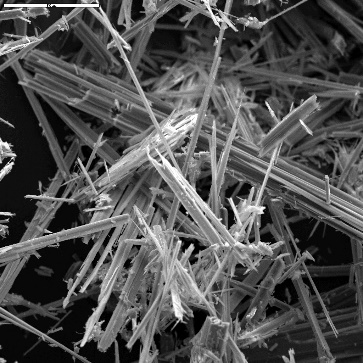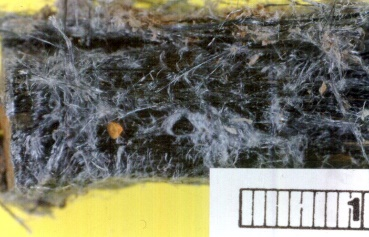What is Asbestos?
Asbestos is a highly heat-resistant fibrous silicate mineral that can be woven into fabrics. It was used in fire-resistant and insulating materials. The word ‘Asbestos’ is derived from early 17th century via Latin, from Greek meaning ‘Unquenchable’.
Types of Asbestos
Six different types of asbestos have been identified. These types are divided into groups:
Serpentine – This variety of asbestos has a layered structure and curly fibres. Chrysotile asbestos is the only type in this category and was the kind of asbestos most often (around 75%) used in buildings in Western Australia.
Amphibole – This kind of asbestos is categorised by a long chain-like structure of fibres that are sharp, straight and easy to inhale. This category is comprised of the remaining five types of asbestos: Amosite, Crocidolite, Anthophyllite, Thermolite and Actinolite.


These types of asbestos are often categorised by their colour, although Thermolite, Anthophyllite andActinolite remain unclassified.
White asbestos – Chrysotile
Brown asbestos – Amosite
Blue asbestos – Crocidolite
Crocidolite (blue asbestos), without a doubt is the most lethal form of asbestos and was mined extensively in Wittenoom, Western Australia.
Asbestos Exposure
When asbestos fibres are bonded to another material such as a cement or resin binder it is known as bonded asbestos. It cannot be crumbled, pulverised or reduced to a powder by hand pressure when dry. Materials in which asbestos fibres are bonded are generally considered to be safe. However, any asbestos containing material can become friable. This happens when the material is broken, drilled, sanded, cut, weathered or worn enabling the toxic asbestos fibres to be released into the air. Asbestos fibres are 50 to 200 times thinner than human hair and once released form a fine dust invisible to the human eye. It is light enough to hang suspended in the air for hours and days long after other dust has settled. Although it is generally accepted that the longer and more intensely a person is exposed to asbestos the more likely they are to develop an asbestos related disease. It should also be noted that Health Organisations around the world agree that no amount of asbestos exposure is safe. Asbestos related diseases are disorders of the lung and pleura caused by inhalation of asbestos fibres. Asbestos related diseases include non-malignant disorders such as Asbestosis (pulmonary fibrosis due to asbestos), Diffuse Pleural Thickening, Pleural Plaques, Pleural Effusion, Rounded Atelectasis and malignancies such as Lung Cancer and Malignant Mesothelioma. The latency period, which refers to the period between first exposure to asbestos and development of disease is rarely less than 10 years and can be as long as 50 years. Pleural plaques sit at the lower end of the asbestos related disease spectrum. Pleural plaques are patches of fibrous thickening on the pleural membrane which can progress slowly and can calcify. Many persons often those who have had only brief exposure develop pleural plaques. Severe chest pain and breathlessness can develop and require treatment using narcotic analgesics. As with many asbestos diseases there is no effective treatment. At the top end of the scale is Mesothelioma. This particularly aggressive form of asbestos related cancer is an incurable malignancy which affects the parietal layer (lining) of the pleura. People diagnosed with Mesothelioma seldom survive for more than a year. It has killed more than 10,000 people in Australia alone since the early 1980’s and is expected to claim the lives of an additional 25,000 people over the next four decades. Interestingly family pets, primarily dogs, have also been increasingly diagnosed and died as a result of Mesothelioma. The latency period in animals differs to that of humans with most dogs that have been diagnosed being an average of approximately 8 years old.
Asbestos in the Home Environment
Asbestos was commonly used in the manufacture of building materials in Western Australia from the mid 1940’s until the late 1980’s. During the 1980’s asbestos cement materials were phased out in favour of Asbestos-free products. From the 31st December 2003 the total ban on manufacture, use, re-use, import, transport, storage or sale of all forms of asbestos came into force. If your home was built prior to the mid 1980’s it is highly likely that it contains asbestos. If it was built between the mid 1980’s and 1990 it is still likely to contain asbestos. It is unlikely to contain asbestos if it was built after 1990.
The following is a non-exhaustive list of where asbestos may be found around the home:
Bonded Asbestos Products
- Roofing
- Shingles and Siding
- (villaboard and similar)
- Exterior and interior wall cladding
- Eaves
- Fencing
- Thermal boards around fireplaces
- Water and flue pipes
Friable Asbestos Products
- Asbestos rope door gaskets in wood stoves
- Loose fill insulation (not common in WA)
- Spray on insulation or soundproofing
- Low density asbestos fibre board
- Insulation on hot water pipes, domestic heaters and stoves (e.g. lagging)
- Backing material on floor tiles and vinyl flooring
- Carpet underlay (not common)
- Textured paint, decorative ceiling coatings
- Heat resistant fabrics
- Brick and plaster sealants fillers and some adhesive products
- Hail of fire damaged, or badly weathered asbestos cement materials
It is important to remember that asbestos cement materials will become friable when they are sufficiently damaged, badly weathered or otherwise deteriorated.
Asbestos Identification
At Cap-It-All Building Inspections we have been trained in Asbestos Identification and utilise this in conjunction with our knowledge and experience to identify ‘Possible’ asbestos when conducting home inspections. The reason that we use the word ‘Possible’ is because careful visual examination and the use of a microscope in a NATA accredited laboratory is the only accepted way to definitely confirm the presence of asbestos in a product.
When asbestos is struck with a sounding tool the sound emitted will sound like that of china rather than the dull thud that is emitted when you strike modern fibre cement sheet products which contain the much safer cellulose fibres to bind them together.
To distinguish between the corrugated, asbestos contained within ‘Super Six’ fencing which still encloses a large number of Perth’ suburb gardens, and, its replacement cellulose fibre containing ‘Hardifence’ is complicated due to manufacturer James Hardie & Co not replacing their moulds as they switched from one product to the other thus producing a new product that is virtually visually identical to its harmful predecessor.
The following are six ways that we may determine ‘Possible’ asbestos contained within ‘Super Six’ fencing from its relatively safe ‘Hardifence’ replacement.
The Age of the House
Any home constructed from 1990 onwards is unlikely to have asbestos ‘Super Six’ fencing installed. The notable exception would be where an owner has re-used second-hand ‘Super Six’ fencing or purchased aged stock from a supplier.
The Number of Ridges
Modern ‘Hardifence’ has only five ridges which will indicate that it does not contain asbestos as ‘Super Six’ fencing was manufactured with seven ridges. However, to confuse the matter, early versions of ‘Hardifence’ were produced with the same profile as ‘Super Six’ and also have seven ridges, therefore this method of identification is inconclusive.
Markings
Where possible, an examination of the edge of the sheet may have ‘Hardifence’ printed on it along with the date of manufacture. Early styles of ‘Hardifence’ have “manufactured without asbestos” and a manufacturing date mark.
Type of Capping
The top capping is used to stop individual sheets from separating. If the capping is fibre cement then the fencing is almost certainly asbestos binded. However, a metal capping would indicate that it is ‘Hardifence’. Many fences exist where no capping at all is fitted.
Scratch Testing
Generally ‘Hardifence’ is slightly softer than the old asbestos containing ‘Super Six’. If you use your fingernail to scratch the surface of the sheet you will normally be able to see the resulting gouge on a ‘Haedifence’ surface whereas ‘Super Six’ will remain unmarked.
Using a Digital Camera
If the fencing has a broken corner or edge you can set your camera to macro mode and take a close up of the exposed fibres. An examination using the digital photos taken may assist in identification. Whilst asbestos fibres are microscopic, the asbestos fibres incorporated in ‘Super Six’ were in large clumps or bundles, whereas the cellulose fibres used in ‘Hardifence’ are more uniformly bonded and fibre lengths are shorter and not as strong. Broken edges of ‘Hardifence’ resemble the appearance of torn cardboard and tend to have a more layered appearance. Probably due to the manufacturing process.
Remember – not to break any suspected asbestos sheeting yourself or you will release the deadly asbestos fibres which may then be inhaled. For details on asbestos removal please refer to the Government of Western Australia Department of Health website.
This technical information is dedicated to my father and mentor Fredrick John Flatt
4th April 1925 – 16th September 1991 killed by Asbestos – Mesothelioma.
